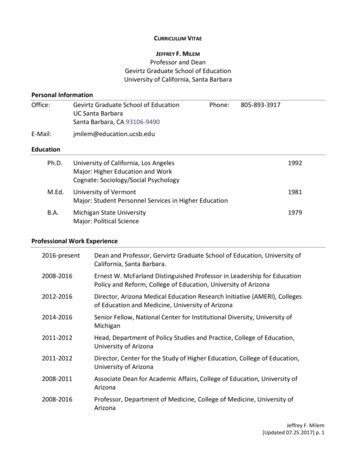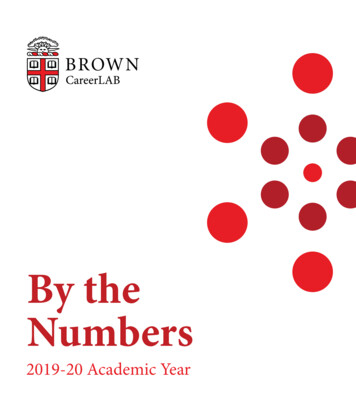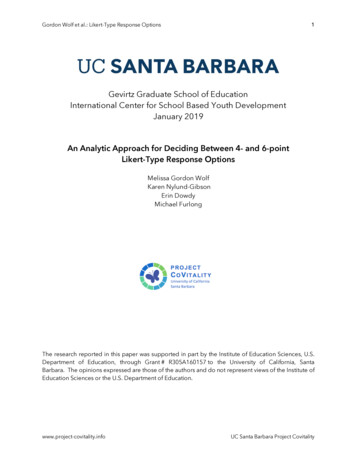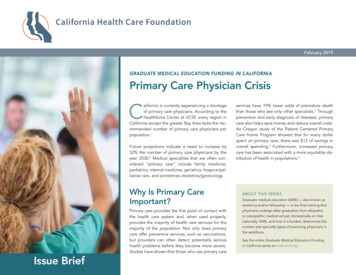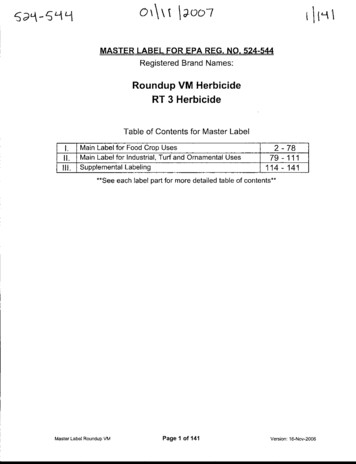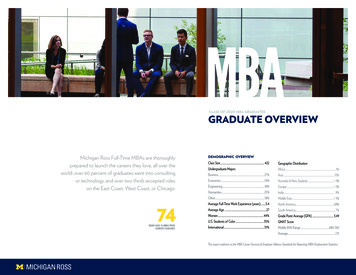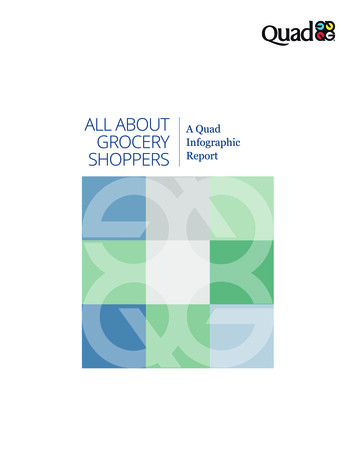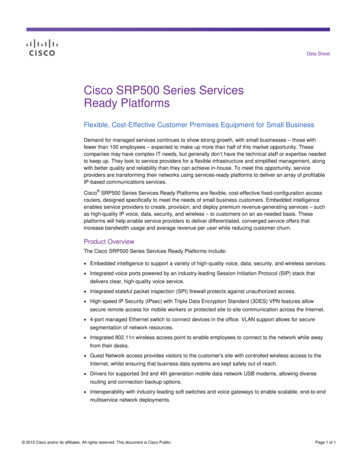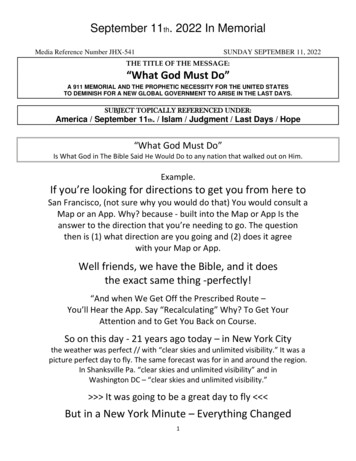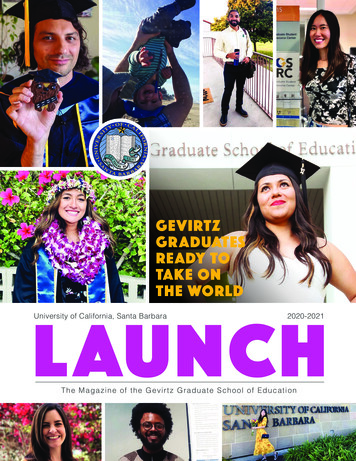
Transcription
GEVIRTZGRADUATESREADY TOTAKE ONTHE WORLDLAUNCHUniversity of California, Santa Barbara 2020-2021T he M ag azi ne of the G e v ir t z G r a du a t e Sc h o o l o f Ed u c a t io n
LaunchThe Magazine of the Gevirtz Graduate School of EducationIn this issue:1Letter from the Dean, Jeffrey Milem2The School’s Strategic Plan Swings into Action4Advancing Equity at the School and Beyond6Building Telehealth and Community in the Midst of a Pandemic8Introducing the Center for Evaluation and Assessment10Helen Neville: A Racial Justice Journey12Faculty Honors, Distinctions, and Awards, 2019-2014Gevirtz School Fellowships, 2019-2016Alumni Honors, 2019-2017Donor Honor Roll 2019-20Gevirtz Graduate School of EducationDeanAssociate Dean for Academicsand Faculty DevelopmentJeffrey MilemDanielle HarlowAssociate Dean for Research and OutreachJill SharkeyAssociate Dean and Faculty Equity AdvisorRichard DuránDirector of CommunicationsDevelopment DirectorContributing Writer/Communications AssistantGraphic DesignGeorge YatchisinJohn HammondKiara ActisZoë BowlusCecilia Martini-MuthLaunch is published annually for the alumni, friends, and donors of UC Santa Barbara’s Gevirtz School.Gevirtz School University of California Santa Barbara, CA 93106-9490(805) 893-5789 profiles@education.ucsb.edu www.education.ucsb.edu Gevirtz Graduate School of Education, UCSBOn the cover: One more way to celebrate some of our 2020 graduates, even if they didn’t get acommencement ceremony because of COVID-19.
LETTER FROM DEAN JEFFREY MILEMDear Members of theGGSE Community,I write to you at a time when the work we do at theGevirtz School has never been more dramaticallynecessary. The international pandemic has laid bare theinexcusable inequality of our health care system whilealso highlighting the importance of science educationand critical thinking. Millions marching in the streets forracial justice have made clear that it is long past timefor our country to come to grips with its racist history.We have never had more work to do to provide mentalhealth care, to make at-home learning as successfulas possible, to further scholarship that leads directly toeducational equality for all.I am fortunate to lead a community that makestremendous impact, helping to inform and improveresearch, policy, and practice in education and appliedpsychology. We are committed to tackling these mostcrucial issues of our age.Consider this 2020-21 issue of Launch/Re:Launch asa snapshot of what we have done and hope to do. Youwill be introduced to Dr. Tarek Azzam as he rolls outthe new and very much needed Center for Evaluationand Assessment. Another of this issue’s stories looksat the exciting changes to the School that are part ofour new Strategic Plan. To adapt to the times, we lookto create new programs, both at the graduate and theundergraduate levels. We hope to announce our firstundergraduate major in the next few years, one withdiversity, social justice, and community service at its core.Launch also offers our manifesto for how to work todismantle racism. The magazine also lays out some ofour first steps in this essential effort: developing bilingualtherapy and educating ourselves in anti-racism. What’smore, this issue features a profile of alumna Dr. Helen A.Neville, a foremost scholar-educator-activist in the areasof race and racism. Her work is a challenge to us all todo more and do better.The School has also been quick to respond to theCOVID-19 crisis. In Launch you will read how ourpsychological services training clinic has steppedboldly into the emerging world of telehealth. Re:Launchcaptures three different research perspectives: fifteenLAUNCH1(l-r) Former Deans NormBoyan and Jules Zimmerwith Dean Milem at anemeriti lunch in 2018.of our graduate students are working on a range ofprojects, including assessing mental health in Black andLatinx communities in the context of COVID-19 andcivil unrest; three of our applied psychology faculty areadapting what they know about school psychology andtrauma to strengthen mental health; and eight membersof the school took part in a journal-writing project,creating a powerful first-person history of the pandemic.I assume many of you already know the beloved Dr.Jules Zimmer, who served on the faculty for more than30 years, half of that as dean. I’d be remiss to leave outsome very big good news—I am the first to hold thenew Jules Zimmer Dean’s Chair at the School. The chairrepresents our shared values of academic excellence,friendship, generosity, vision and a commitment to thefuture—all values Jules himself embodies.In closing, there’s only so much one magazine cancapture, so we invite you to learn even more by visitingour website (education.ucsb.edu)—where among otherthings you can read more from Dr. Neville and dive intoall the COVID-19 journal entries.Best wishes,Jeff MilemGEVIRTZ GRADUATE SCHOOL OF EDUCATION
THE SCHOOL’S STRATEGIC PLANSWINGS INTO ACTIONFollowing Dean Milem’s charge, faculty,staff and students came together innumerous meetings, planning sessions,and work groups during 2018-19 to charta collective version of the School’sfuture. The resultant Mission for this newfive-year strategic plan is:1. To conduct scholarly inquiry into educationand applied psychology, especially intocommunity responses to the opportunitiesand challenges posed by individual,economic, linguistic, and cultural diversity inour multicultural society;2. To educate scholar researchers and scholarpractitioners to address educationalopportunities and challenges arising fromdiversity;3. To develop and maintain exemplaryprograms that serve as models for teaching,research, and service.As a way to accomplish all three points of themission, the School is currently developing itsfirst undergraduate major. This major changeat the School, pun intended, “Stems from thedesire to make important contributions to theuniversity through the design and implementationof an undergraduate major that draws uponour expertise as scholars in education, literacy,research, evaluation and policy, social justice,community service, applied psychology and humandevelopment,” says Dean Milem. “This vision isdriven by our desire to be responsive to all membersof our state and nation; to create the conditions thatwill allow us to achieve educational and social justice;and to prepare teachers, scholars, and practitionerswho will provide leadership in these efforts.”There’s little doubt the undergraduate body of UCSanta Barbara would be eager to take advantageLAUNCH2of a Gevirtz School major. Right now, the Schooloffers the two most popular minors on campus—Applied Psychology and Educational Studies. “TheMinors, however, only allow for students to take afew courses, not a full rigorous Major that wouldprepare them for future opportunities,” points outProfessor Shane Jimerson, who has led the workgroup developing the new major. “There are noother departments on campus that can provide thecontent, knowledge, and preparation that we can.”That new major—with an official name still tocome—will be built around four focus areas:Human Development; Diversity and Social Justice;Research, Evaluation, and Policy; and Fieldworkand Community Service. Students graduatingwith this new B.A. could pursue careers in fieldssuch as scholarship, teaching, therapy, socialwork, advocacy, policy planning, government, andcommunity support for children and families.Nothing drives the need for the new majormore than the values captured in the 2020-2024strategic plan. These values include: Embracing our responsibility as a Minority–Serving Institution (MSI) to catalyze thestrengths of diversity and address thechallenges of our complex world. Teaching leaders who will help buildequitable communities locally and globally. Transforming school and community–based systems to better serve vulnerablepopulations. Collaborating with interdisciplinary andcommunity partners to conduct impactful,respectful, equity–serving and community–engaged service and research.Students in the Major working through the fourfocus areas will also be a crucial part of several newinitiatives at the School, including the Center forEvaluation and Assessment (see an article aboutthis project on p. 8), the Center for Publicly EngagedGEVIRTZ GRADUATE SCHOOL OF EDUCATION
Scholarship led by Dr. Victor Rios from Sociologyand Dr. Rebeca Mireles Rios from Education,and the nascent Harding University PartnershipSchool Community Resource Center.“Our privilege as educators is ourwillingness and ability to work toinfluence and transform scholarshipand service for the betterment ofsociety,” Dean Milem has said.“I look forward to the paths ahead.”The School hopes that the new Major will bejoined with other programmatic changes overthe next few years (there is a long approvalprocess at the School, University, and evensystem level that will take some time, no doubtcomplicated by the COVID-19 pandemic).The School is also considering expanding itsoffering of Master’s degrees, and is already inthe process of reinstating a terminal M.Ed. inSchool Psychology.“With shortages of school psychologistsextensively documented in the State ofCalifornia and nationally, the Department ofCounseling, Clinical, and School Psychologyworking group determined that the Masters inEducation and credential program will meet acritical and urgent need for school psychologistsprepared to meet the needs of diverse childrenand families across the state of California,nationally, and internationally,” Dr. Jimerson,a school psychologist himself, makes clear.The need for a wave of school psychologistscouldn’t be more evident, given the AmericanSchool Counselor Association recommends a250-to-1 student-to-counselor ratio and theCalifornia state average is 609-to-1.LAUNCH3GEVIRTZ GRADUATE SCHOOL OF EDUCATION
ADVANCING EQUITY AT THE SCHOOL AND BEYONDThe Gevirtz School has historically been guided by an unwavering commitment to improving the knowledge baseabout educational and applied psychology issues, providing professional development for the future leaders ofpublic education, and ensuring high quality education for all of our nation’s children. Recent events in the countryhave led the School to re-commit its efforts to social justice and racial equity. There are many ways we hope toaccomplish such work, starting with a statement by the school deans posted on June 2, 2020.In June, UCSB students, staff, and faculty marched insupport of Black Lives Matter. (credit: Dr. Glenn Beltz)who harm members of ourcommunity. And as importantly,and consistent with our recentlyestablished strategic plan, wereaffirm our responsibility andduty as a school, as teachersand scholars, and publicservants to use educationresearch, practice, and policytools to dismantle racism andpromote the well-being of ourmany diverse communities.Taking Action to Dismantle Racism:A Message from the Gevirtz School DeansOver the past weeks, we havewitnessed the senseless andviolent deaths of AhmaudArbery, who was shot and killedby white supremacists who feltentitled to confront him aboutbeing in the neighborhood inGlynn County, Georgia wherehe was jogging; Breonna Taylor,a black woman in Louisvillewho was shot eight times bypolice who fired into her homemore than 20 times while shelay in her bed; and the murderof George Floyd, whose lifewe saw slip away as he layhandcuffed and face down onthe pavement while a whitepolice office kneeled on his neckLAUNCHwith his full weight for nearlynine minutes as Mr. Floyd criedout for help saying that he couldnot breathe.These horrific acts remind usof the lasting, insidious effectsof racism and white supremacyin our country. They are theoutcome of entrenched societalmaladies that we must confrontand resolve through immediateaction while we simultaneouslypursue longer-term strategiesthat facilitate systemic, structuralchanges. Members of theGevirtz School community standbehind calls for constructiveand legal actions that will deliversocial justice forthwith to those4Consistent with our strategicplan vision to “be a leaderin addressing pressingsocial justice issues throughinterdisciplinary collaborationsgrounded in educational andapplied psychological research,teaching, and service,” theGevirtz School will: Embed social justiceconcerns as centralparts of our curriculumby critically examiningour nation’s history ofeducational inequities,mass incarceration, statesanctioned violence, andinadequate access to qualityhealth care. Increase the diversity of ourhires and hires of personswhose work focuses on thepursuit and attainment ofsocial justice.GEVIRTZ GRADUATE SCHOOL OF EDUCATION
Examine disparities within our own School anddevelop action plans that allow us to facilitateeducational equity, access, and success for allstudents, staff, and faculty. Expand our collaborations with schools,community groups, and government agenciesto move forward an agenda of social andeducational justice in our communities.Andrés Consoli Makes theCase for Bilingual TherapistsFinally, we invite all members of the Gevirtz, UCSB,local, national, and international communities to workwith us to focus our individual and collective action todismantle racism and transcend issues of educationaland social inequity.Jeffrey F. Milem, DeanRichard Durán, Associate DeanDanielle Harlow, Associate DeanJill Sharkey, Associate DeanBriana Villaseñor, Assistant DeanThe School is committed to a full slate of the Dean’s Lectures onEducation, Diversity, and Democracy, like this event in 2018.Dr. Andrés Consoli of the Department of Counseling,Clinical and School Psychology made the casefor the critical importance of bilingual training in arecent article posted by the American PsychologicalAssociation. Here are some excerpts from the article,which can be found at nce for any professional canonly come from appropriate education,training, and experience, Consoli says.For bilingual psychologists, the legs ofthat tripod need to rest firmly in bothlanguages, because the prospectiveclient population ranges from, in thiscase, using only Spanish—or onlyEnglish—to being fully bilingual.And Spanish must be an integral partof the psychology curriculum, including“discipline-specific courses deliveredin Spanish,” bilingual practicums, andsupervision in Spanish, he says.“The time for bilingual training is long overdue in aprofession in which people make their living talking,”Consoli says. He adds, “Multicultural competenceand multicultural humility are crucial variables in thedelivery of mental health services.”LAUNCH5Educating the Schoolin AntiracismEven in summer, teacher’s love learning. Followingthe murder of George Floyd and the #BLM movementthe Teacher Education Program (TEP) engaged inlearning more about discrimination and systemicracism in our country. Assistant Teaching ProfessorAmber Moran led the way to organize a readinggroup of 28 TEP faculty examining Ibram X. Kendi’sHow To Be an Antiracist. The discussion sessionsso far, Moran says, have been “a natural space forus to pause and really reflect. The book has donea great job of laying out different lenses on racism.We’re developing a common language that will besuper helpful as we move forward.” Not only will theyconsider action plans once the book is finished andfully considered, but it’s also just the first step of suchdeliberation—soon the entire Gevirtz School might beworking in reading groups, too.GEVIRTZ GRADUATE SCHOOL OF EDUCATION
BUILDING TELEHEALTH ANDCOMMUNITY IN THE MIDST OF A PANDEMICMarch 14, the day that Chancellor HenryYang announced remote instruction forspring quarter, was also the day thatthe Hosford Clinic staff said, “COVID-19will not stop us from providing therapy.”Within one month, the faculty were taskedwith switching from in-person services tocompletely remote services for all threespecialty clinics at Hosford. This processwas made possible through the hardwork of the Hosford Clinic and UC SantaBarbara, as well as the larger community ofpsychologists across the country.Former Hosford Clinic Director Heidi Zetzer, whojust stepped down from her post in June, playeda vital role in building telehealth. This processincluded acquiring the best technology to practicetelehealth, creating policies and procedures thatmet the standard of care, and training personnel.Her excellent leadership, and the research efforts ofthe clinic staff, made this monumental task not onlypossible, but a huge success. Current Clinic DirectorSteve Smith says, “The work Heidi has done isnothing short of heroic.”An essential part of building telehealth was acquiringthe technology necessary to deliver remotetreatment. A team of experts was needed to navigatehow to email clients securely, videoconferencewith clients and student clinicians, and accessclient records through an electronic health recordsystem. It was also important that the equipmentand software met HIPAA requirements protectingpatient information. Shannon Rivard, Departmentof Counseling, Clinical and School PsychologyAdministrator, Dyan Wirt, Clinic Administrator,Doug Drury, UCSB IT Strategist, Sam Horowitz,UCSB Chief Information Security Officer, and afull complement of UCSB IT specialists workeddiligently to have the telehealth therapy programready by April.The transition to a virtual format created challengesin regards to training student clinicians andconducting therapy over Zoom. Zetzer points outthat the training of psychologists and the provisionof clinicians is very relational and built on personalconnections. She explains, “Over Zoom, it is harderto build and maintain these relationships becauseWhat a therapysession lookedlike pre-COVID.LAUNCH6GEVIRTZ GRADUATE SCHOOL OF EDUCATION
you lose the informal interactions, such as studentsstopping into my office to ask a question, or seeingthem around the building.” Similarly, Smith explainedthat therapy over Zoom is quite an adjustment,as the loss of body language and face-to-faceinteraction makes it harder to get a full sense of thepatient. “I love doing therapy in person,” he states, “Ifind it easier as a therapist to connect with people inthe room with me.”navigate telehealth. “Luckily, I have colleagues atUCSB and throughout the country who direct orsupervise in psychology training clinics,” she says.“Their perspective, wisdom, shared resources, andreassurance made all the difference and helped memove forward with building telehealth services.”During this global pandemic, the supervisors atHosford Clinic developed a newfound appreciationfor the resilience of those around them. The studentThat said, throughout the transition to a virtualclinicians showed resilience by adopting a telehealthformat, the clinicians have also found many positivesystem all while being physically and emotionallyaspects of working remotely. Smith sees telehealthimpacted by the pandemic, Anti-Black racism,as serving the clinic well in the future. “A hugeracial injustice, threats to the completion of theirbenefit of the telehealth service is being able toeducation and supervised clinical training, threatsaccess clients across the state, and serve a largerto DACA, and threats to LGBTQI rights. The largerpopulation that could not becommunity of psychologistsreached before,” he explains.across the countryMiya Barnett, Director ofdemonstrated resilience byWhat good is feeling good ?POS ITIVE C O PING IN A TIME O F CR ISISthe Parent-Child Interactionvolunteering information whileTherapy Clinic (PCIT), statedscrambling to develop theirPOSITIVE AND PAINFUL EMOTIONS CO-OCCURthat PCIT, which is a modelown telehealth systems. TheDecades of research has shown that even seasons of lifedominated by deep suffering, such as bereavement orfor coaching parents, hasclinic directors, administrators,acute trauma can include moments of positive emotionalreprieve. Experiencing positive emotion amid thesetranslated well over Zoom.and supervisors displayedperiods of stress promotes better long-term outcomes,including less depression and stronger social bonds.In the clinic, therapists standresilience by developing aPositiveemotioncopingstrategiescaninclude:behind a one-way mirrortelehealth program fromand observe and coachscratch in order to provide1. CREATING POSITIVE MOMENTSSometimes we need to consciously scheduleparents interacting with theirhelp and healing to patients insituations or activities likely to make us feelgood. We can try for any positive emotion,child. The transition to Zooma time of uncertainty. Zetzerincluding (but not limited to) curiosity, calm,amusement, joy, hope, gratitude, and/or love.worked seamlessly becausestates, “While the ‘tele’ part2. PROBLEM-FOCUSED COPINGthe therapists were alreadyof telemental health is whatSome of life's problems are too big or toocomplex to solve alone. In these times, we canaccustomed to conductinggenerally gets emphasized,refocus on solvable tasks (e.g. making dinner,picking up medicine) within the unsolvabletherapy in two differentit is the human aspect of theproblem. Keep tasks small and incremental;What is the first step of the first step?rooms. What’s more, Barnettwork that deserves the most3.FINDING MEANING NOTICING THE GOODpoints out that “being able toattention.”In times of chronic stress, many peopleinfuse new or deeper meaning into otherwiseobserve families in their homeordinary daily events. A walk in the sun or aphone call with a loved one may elicit deeperenvironment is an especiallygratitude than before,rewarding experience.”As the clinics underwent manychanges, the faculty and stafffound an immense appreciationfor their colleagues’commitment to each other’swell-being. Zetzer admits thatat first she wondered if it wouldbe more beneficial to closethe clinic for the academicyear to take more time toLAUNCHEmotional balance is allowing for a full rangeof pleasant and painful feelingsH O N O R I N G A L L O W I N G P A I N F U L E M O T I ON SRemember that chronic avoidance of emotional pain canworsen distress in the long-run. Noticing, describing,allowing, and accepting uncomfortable and painfulemotion is an important part of coping with extendedcrises. No matter what emotional experiences you arehaving, try to treat yourself with understanding andwithout judgment. You're coping and that is good enough.SELECTED REFERENCESBonanno, G. A., Moskowitz, J. T., Papa, A., & Folkman, S. (2005)Folkman,S.& Moskowitz, J. T. (2000); Fredrickson, B. L. (2001);Tugade, M. M., & Fredrickson, B. L. (2007).CAROL ACKERMANPOSITIVE PSYCHOLOGY CLINIC7GEVIRTZ GRADUATE SCHOOL OF EDUCATION
TAREK AZZAM LEADS THE NEW CENTERFOR EVALUATION AND ASSESSMENTAzzam gives a pertinent example, relating the storyof a time he evaluated a student retention programat an un-named higher education institution. Thatinstitution was happy to hear the treatment groupperformed better than the control group, but it wasless happy to hear the results of additional analysis:looking at the results by ethnicity, Latinos in thetreatment were dropping out at an even higher ratethan those in the control group. “Further analysisshowed the mentors in the program didn’t have thesame background as their mentees,” Azzam recalls,“so they unintentionally assumed everyone camein with the same level of cultural capital.” Theseevaluation results led to changes in the program, andafter recruiting more first-generation scholar mentors,a re-evaluation showed the initial issue was solved.Associate ProfessorTarek Azzam is thedirector of the newCenter for Evaluationand Assessment.Tarek Azzam, Associate Professor in the Departmentof Education and Director of the just establishedCenter for Evaluation and Assessment (CEA) atthe Gevirtz School, realizes program evaluation isfar from a neutral tool. “I conducted a survey ofevaluators,” he recalls, “and asked them, ‘Howoften are you asked by clients to modify yourfindings?’ The answer was 76% of the time—it’svery common.” A shocking answer like that feedsAzzam’s mission, though. “That’s why I want to trainevaluators, as there are lots of legal, ethical, andpolitical concerns,” he says. “If you’re just trained todo research, you rarely learn about those issues.”For while organizations always want to claim theyare moving to evidence-based decision-making,sometimes that evidence doesn’t tell them what theywant to hear. Azzam, then, not only has to design auseful evaluation but also has to sell its efficacy, evenif he has to deliver less than a 100% good news.“If an evaluation is developed in a responsible anduseful way, it can make the program more effective,”he says. “It can also highlight social inequities andput a light on issues otherwise ignored.”LAUNCH8Solving social problems is what drew Azzamto evaluation in the first place, when he was anundergraduate at UC Santa Barbara (yes, he’sa Gaucho). While he was always interested inresearch, he explains, “I was interested in researchfor social betterment, to assist communities andvulnerable populations.” He was fortunate to workwith legendary professor Dr. Daphne Bugental in thePsychology Department on research examining theeffectiveness of a child abuse program and he washooked. Unfortunately, Bugental passed away a yearbefore Azzam joined the GGSE faculty, so he nevergot to work with her as a colleague.Azzam, who joined the GGSE faculty in 2019, cameto UCSB from Claremont Graduate University, wherehe had been Associate Professor and one-timedirector of The Evaluators’ Institute. He insists he stillloves the work, saying, “I still get a kick out of it,” inparticular because he consistently develops cuttingedge methodologies and approaches, warningthat one of the big pitfalls is assuming one type ofevaluation fits all situations. He also welcomes themovement toward certifying evaluations that hasoccurred internationally in countries like Canada,New Zealand, and Japan.GEVIRTZ GRADUATE SCHOOL OF EDUCATION
Azzam has worked onevaluating programs like theInternational BaccalaureateMiddle Years Programme.(Credit: InternationalBaccalaureate)His plans for the CEA are tripartite. First, the Centerwill provide evaluation services to both UCSB andthe regional community and eventually beyond.Second, it will be a hub to train evaluators, tohelp build evaluation capacity for organizations.Third, it will conduct research to develop newLAUNCH9methodologies—for example Azzam is currentlyexploring how crowdsourcing can alleviate issuesof time and money during evaluations. Can theybe used as control groups? As a way to validateinstruments?Overall, his general pitch to a possible organizationsums up his and the Center’s approach. “I tell them,‘I can do the check-the-box evaluation, but it won’tbe that useful to you,’” he says.“Why not try to figure out andcollect and report relevant anduseful information to help continuethe development of your programand respond to emerging needs?This is the type of information thatwould be most helpful for you asdecision makers.“Evaluation can be useful and successful, heclaims, “When there’s stakeholder buy-in, when it’sresponsive to informational needs of the program,and when it’s viewed as credible.” The political edgeto evaluation can’t be ignored—before it begins allparties have to agree on what results might signalsuccess. He points to the national evaluation ofabstinence-only sex education as an example. Theevaluators knew people had definite beliefs going in,“So they formed an advisory committee from bothcamps and that group agreed on the methods andmeasures first,” he relates. The evaluation foundabstinence-only sex education had no effects—itdidn’t prevent pregnancies but also didn’t increaseSTDs in teens. So both groups came away a bitdisappointed with the results, even if the evaluationled to the end to federal funding of such programs.“When you have something controversial, you don’tignore it,” he sums up. “You anticipate it that it mightblow up and plan for it as much as possible.”GEVIRTZ GRADUATE SCHOOL OF EDUCATION
DR. HELEN A. NEVILLE:A RACIAL JUSTICE JOURNEYInstead of using the term white supremacy, I like to talk aboutit as the myth of white supremacy. This underscores the factthe idea of supremacy is a false one; instead, there is a myththat white individuals and white systems and white cultureare superior to Black and Latinx and Afro-Latinx and variousdifferent Asian and Indigenous communities.So, what does this look like in the classroom? The myth ofwhite supremacy shows up in the content of the course—what’s on the syllabus, the assigned readings, the theoriesdiscussed, and the topics covered. It reflects the person’sapproach to the specific topic. It is less about who is coveredin the course, but rather who is not included and why? If aneducator does not specifically say, “I adopt an anti-racist, socialjustice oriented, or decolonized approach to teaching,” thenmany times the structure and content of the course support themyth of white supremacy.Alumna Helen A. Neville (CounselingPsychology, Ph.D., ’93) is a forcefor transformation. A professor ofEducational Psychology and AfricanAmerican Studies at the University ofIllinois at Urbana-Champaign, she isa national leader in the areas of race,racism, and racial identity, and diversityissues related to well-being. From beinga past President of APA Division 45, theSociety for the Psychological Study ofCulture, Ethnicity, and Race, where shefounded the Radical Healing Collective,to co-editing/authoring eight books and(co)-authoring over 90 journal articlesand book chapters, Neville has built acareer of social justice work.How we as educators communicate and how we expectstudents to communicate fits into this notion of the myth ofwhite supremacy. For example, the question “why don’t wehave a civil discussion?”, often is designed to silence people’saffect around their oppression. In essence, the questionencourages people not to express anger over racial and otherforms of op
The Magazine of the Gevirtz Graduate School of Education In this issue: 1 Letter from the Dean, Jeffrey Milem 2 The School's Strategic Plan Swings into Action 4 Advancing Equity at the School and Beyond 6 Building Telehealth and Community in the Midst of a Pandemic 8 Introducing the Center for Evaluation and Assessment .
